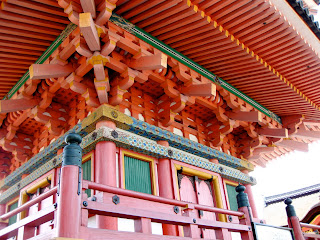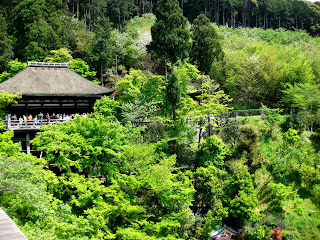Sorry these posts have been so far between but I've been busy living the life of a typical Japanese student. First I would like to assure all of my readers that I am no longer in a "EFF Japan" kind of mood. But it still is a little bothersome to be on crowded trains, especially when you realize that the train isn't that crowded, but that the Japanese are just really poor utilizers of space. (They cram in the area right by the doors while the middle parts of the train are relatively empty) BUUUT otherwise I'm not hating so hard on Japan (not that I hated it earlier, but it drove me a little crazy). SO what have I been up to that makes me a typical Japanese student??? Well read on!
The first obvious answer is that I've been busy studying and doing homework. Lately my classes have decided to pile on the exams and assignments-probably because it's about that time for midterms. I just took my first major Kanji exam (Japanized Chinese characters- if that makes any sense), which was fairly easy for me since I have taken a few years of Chinese. Producing the Kanji was easy, but writing out the Kanjis in Hiragana was the difficult part.
Maybe I should briefly describe the craziness that is Japanese characters since I don't know how familiar people are with written Japanese. Okay, so Japanese has 3 (well technically 4) different written forms. Hiragana, Katakana, Kanji, and Romanji. Some of them are difficult to explain but I'll try my best.
Hiragana is the written form used for Japanese words...or basically any words not borrowed from the West. It is one of the more common character forms you'll see around Japan. Example of Hiragana: すごい! (wow/amazing) ともだち(friend)
Katakana is a lot easier to explain. It is used for loanwords (most commonly loanwords from America or Europe). The only troublesome thing about them is when you are trying to write out the word because it sounds just like the American counterpart most of the time. Or else it sounds only vaguely like the original American word and you feel like your playing a game of Mad Gab. Katakana example: マラソン (pronounced ma-ra-so-n which is marathon) or アクラセサリー(pronounced A-ku-ra-se-sa-ri which is accessory)
Kanji is considered to be the most difficult. These are the "Japanized" Chinese characters. They were characters borrowed from China and used for certain Japanese words or Chinese borrowed words. Kanji words can be written in Hiragana. In fact many Japanese are unfamiliar with many Kanji and can only produce the Hiragana of it. There are many tv game shows where Japanese are shown a Kanji character and must say what it means. I have no idea how you know if a Hiragana word has a corresponding Kanji, maybe it's just something you learn and must memorize.
Example of Kanji: 日 which has a variety of pronounciations. it can be り(ri) or び(bi) and maybe others. Usually it means day. 金 can be pronounced かね(ka-ne) or きん (kin) and means gold or money depending on the pronunciation (if spoken) or context (if written) Other example: 泳ぎます or およぎます to swim
Romaji kind of doesn't count as an actual Japanese writing form because it is just the romanization of Japanese words. So the words I wrote in parentheses. Most places in Japan have the Romanji of cities so foreigners can know when they have reached their train station or how to pronounce things. Example of Romanji: watashi no namae wa keri desu. (my name is keri)
What makes written Japanese even more difficult is that you can find all four of these different forms in one single sentence. EX:私の名前はケリです。私の大学わ kaihinmakuhari にあります。(my name is keri. my university is in Kaihinmakuhari)
difficult.
Other than school I have been participating in a lot of typical Japanese practices, both traditional and modern.
One of the modern traditional cultural events I participated in is a festival called sanja matsuri. Sanja Matsuri is one of the largest of the three shrine festivals in Tokyo prefecture. Its prominent parades revolve around three mikoshi (three portable shrines referenced in the festival's name), as well as traditional music and dancing. Sanja Matsuri is held every May for three days in Asakusa. Over the course of three days, the festival attracts 1.5 to 2 million people each year. The mikoshi are carried around by large groups of people and shaken/jostled around all over the city. This is because they want to bless the city, and so they must shake the shrine to wake up the deity inside of the mikoshi. Something really exciting about Sanja Matsuri is that the Japanese organized crime (Yakuza) participates with the local citizens. So this festival is a symbolic way of binding the community together. I was even lucky enough to see some of the Yakuza, which was a little scary, but really exciting and interesting.
Here are some photos.

Traditional Matsuri garb. One of the smaller mikoshi.

Enlarge this and check out the Yakuza on top of the mikoshi (the guy with the tattoo'd shoulder)

I really enjoyed Sanja Matsuri. But it was a really really hot day and it was made even hotter by the massive crowd of people at the event. But it was really exciting because all of the Japanese would dance, chant, and clap while the mikoshi was being carried around so it was really high energy and fun!
I meant to write more on this blog but it's getting late and I need to get up earlier tomorrow to go to Okinawa, so I'll save the rest for later. I will do massive blog updates when I get back!


































